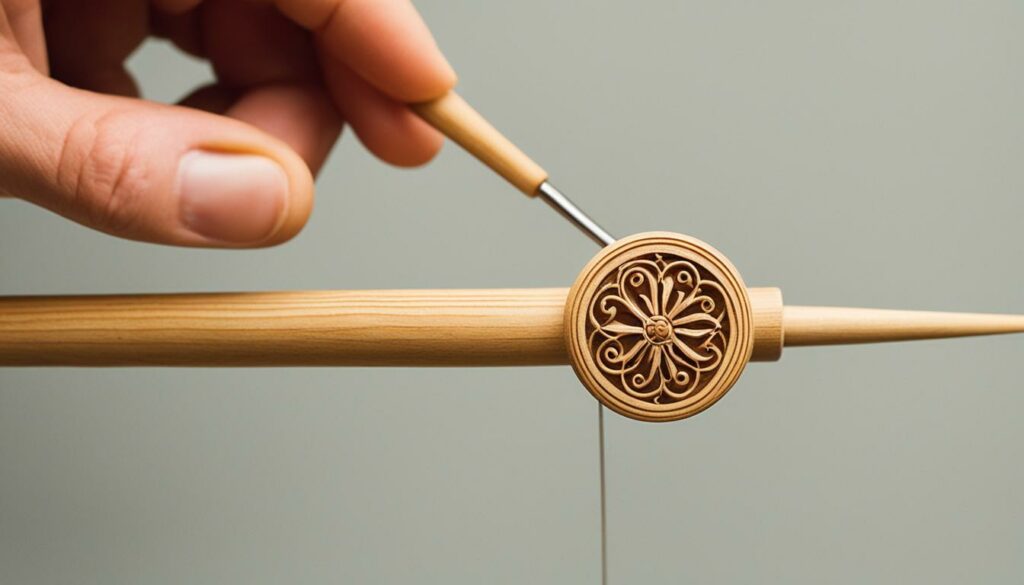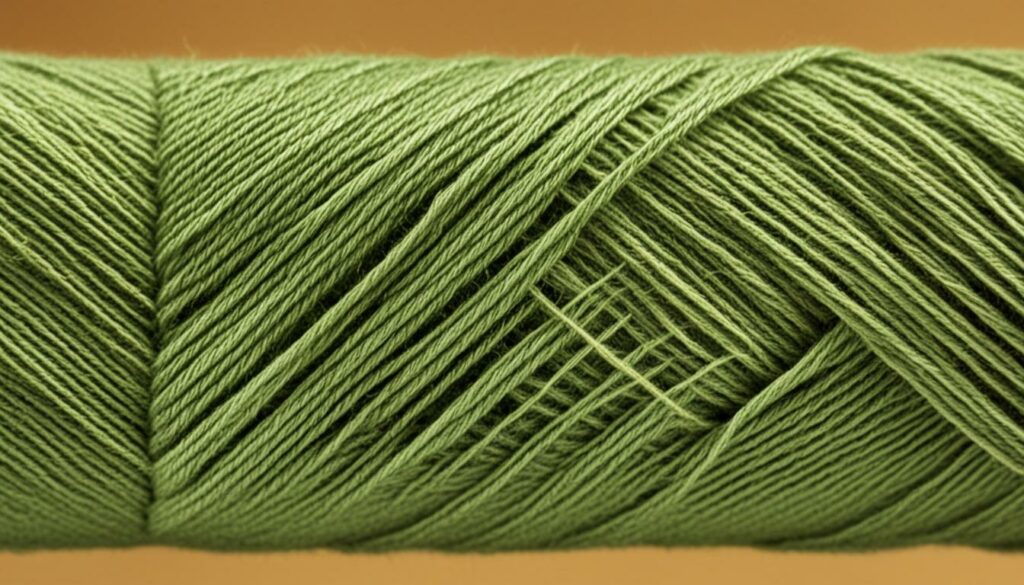Have you ever thought about how quickly you can spin yarn? What speed can you achieve to create those unique and beautiful skeins? The answer may be surprising to you.
When it comes to spinning yarn, the speed at which you can spin depends on several factors. From the type of yarn you’re spinning to the drafting speed, there are various elements that come into play. But what is the maximum speed you can achieve? And can you spin yarn faster than you currently are? Let’s dive into the details and find out.
Key Takeaways:
- Spinning speed can vary depending on factors such as drafting speed and the type of yarn being spun.
- While drafting speed sets a limit of around 8 to 10 yards per minute, spinning woolen yarn can be done at faster speeds.
- Commercial wheels designed to spin at 1,200 rpm can handle worsted weight yarn at fast spinning rates.
- Fine yarns require slower spinning speeds to accommodate the higher twist needed.
- Handspindles can offer an efficient and faster alternative to spinning wheels, reaching speeds of up to 10,000 RPM.
Techniques to Increase Yarn Spinning Speed
When it comes to yarn spinning, increasing your speed can significantly improve your efficiency and productivity. In this section, we will explore some effective techniques to help you spin yarn faster and achieve optimal spinning speed.
Practice Efficient Drafting
One technique to increase your yarn spinning speed is to practice efficient drafting. Drafting refers to the process of pulling and thinning the fibers as you feed them into the spinning wheel. By mastering quick and efficient drafting, you can feed the fiber at a faster rate, resulting in increased spinning fiber speed. Focus on maintaining a steady, fluid motion while pulling and thinning the fibers, allowing for a smooth and continuous spinning process.
Choose a High-Speed Flyer/Bobbin Assembly
Using a wheel with a flyer/bobbin assembly that can rotate at higher speeds is another effective technique to enhance your spinning speed. This is particularly beneficial when spinning woolen yarn, as it requires a faster rotation speed to achieve optimal results. Look for spinning wheels specifically designed for higher speeds, allowing you to spin yarn at a faster rate without compromising the quality of the finished product.
Utilize Differential Rotation Speed (DRS) System
Another technique to increase yarn spinning speed is to utilize a differential rotation speed (DRS) system. DRS allows for differential speeds between the flyer and bobbin, providing more control over the spinning process. This system can be particularly advantageous when spinning fine threads or delicate fibers, as it makes the spinning process easier and faster. By implementing a DRS system, you can enhance your spinning efficiency and achieve optimal spinning speed.
“By practicing efficient drafting techniques, using a high-speed flyer/bobbin assembly, and utilizing a DRS system, you can significantly increase your yarn spinning speed and achieve optimal results.”
By implementing these proven techniques, you can improve your spinning efficiency and increase your yarn spinning rate. Whether you’re a beginner or an experienced spinner, these techniques can help you achieve faster and more productive spinning sessions.
The Impact of Yarn Thickness on Spinning Speed
The thickness of the yarn you’re spinning can greatly influence the speed at which you can spin. Different yarn thicknesses require varying amounts of twist, which in turn affects the spinning speed. Let’s take a closer look at how yarn thickness impacts spinning efficiency and how to achieve faster spinning rates.
The Relationship Between Yarn Thickness and Spinning Speed
When spinning larger yarns, you typically require less twist, making it quicker to produce the desired amount of yarn. This allows for faster spinning speeds, increasing the yarn spinning rate. The larger diameter of the fibers also contributes to the ease and efficiency of spinning.
On the other hand, fine yarns, such as lace weight singles or fines, require more twist to achieve the desired characteristics. This means that a slower spinning speed is necessary to insert the required amount of twist. The delicate nature of the fibers also adds to the challenge of spinning fine yarn quickly, as it requires more precision and control.
It’s important to find a balance between speed and quality when spinning yarn. While larger yarns may be spun faster, fine yarns require a slower spinning speed to ensure proper twist insertion and maintain the integrity of the delicate fibers. By understanding the characteristics of different yarn thicknesses and adjusting your spinning speed accordingly, you can maximize efficiency and achieve the desired spinning rate.
Optimizing Yarn Spinning Efficiency
To increase your yarn spinning rate and overall efficiency, consider the following tips:
- Choose the right fiber: Some fibers naturally lend themselves to faster spinning due to their structure and characteristics. Experiment with different fiber types to find ones that are easier to spin quickly.
- Practice and develop your skills: As with any craft, practice plays a crucial role in improving your spinning speed. Regular practice sessions can help you refine your technique, increase your drafting speed, and achieve faster spinning rates.
- Use appropriate tools and equipment: Utilize spinning wheels or spindles that are designed for higher spinning speeds. These tools are specifically engineered to handle faster rotations and can significantly increase your spinning efficiency.
By implementing these strategies, you can enhance your spinning efficiency, increase your yarn spinning rate, and achieve faster results.
| Yarn Thickness | Spinning Speed |
|---|---|
| Larger Yarns | Quicker, faster spinning speeds |
| Fine Yarns | Slower spinning speeds for precise twist insertion |
Understanding the relationship between yarn thickness and spinning speed is key to optimizing your spinning process. By adapting your technique and equipment to the specific characteristics of the yarn you’re working with, you can achieve faster spinning rates and improve overall efficiency.

The Advantages of Handspindles for Speed Spinning
When it comes to speed spinning, handspindles offer unique advantages that can enhance your spinning experience. While spinning wheels are popular and versatile tools, certain types of spindles, such as the takli, can outperform them in terms of speed and efficiency.
One of the key advantages of handspindles is their ability to reach high speeds. In fact, some handspindles, known as speed demon spindles, can rotate at incredible speeds of up to 10,000 RPM. This surpasses the spinning speed of traditional treadle wheels, allowing for faster yarn production.
Handspindles are particularly well-suited for spinning fine singles. With a handspindle, you can achieve a production rate of around 3 yards per minute or even better. This makes handspindles a great choice for spinning delicate fibers and creating fine, lightweight yarns.
Although using handspindles requires coordination and practice, they offer increased speed and control for certain types of yarn and spinning techniques. With practice, you can become proficient in handspindle spinning and unlock its full potential.
The Benefits of Handspindles for Speed Spinning
Using handspindles for speed spinning comes with several benefits:
- Portability: Handspindles are compact and lightweight, making them easy to carry and use wherever you go. This portability allows you to take your spinning projects with you and make use of every spare moment.
- Diverse Fiber Compatibility: Handspindles can accommodate a wide range of fiber types and preparations, allowing you to experiment with different materials and create unique yarns.
- Cost-Effectiveness: Handspindles are generally more affordable compared to spinning wheels, making them a budget-friendly option for spinners who want to explore speed spinning without a significant investment.
If you’re considering exploring the world of handspindle spinning, it’s important to choose the right handspindle for your needs. Consider factors such as weight, balance, and personal preference when selecting a spindle to ensure a comfortable and enjoyable spinning experience.

| Advantages of Handspindles for Speed Spinning |
|---|
| Ability to reach high speeds |
| Well-suited for spinning fine singles |
| Portability |
| Diverse fiber compatibility |
| Cost-effectiveness |
Tips for Spinning Yarn with a Handspindle
When it comes to spinning yarn with a handspindle, selecting the right spindle is crucial. We want a spindle that we are familiar and comfortable with, enabling us to maximize our spinning speed and efficiency. Here are a few tips to help you make the most of your handspindle spinning experience.
Selecting the Perfect Spindle
Choosing a spindle that suits your needs and preferences is essential. Consider factors such as the spindle’s balance, weight, and ease of putting in twist. The right spindle will allow for smooth and controlled spinning, enhancing your overall speed and quality. Experiment with different spindle types and sizes to find the perfect match for your spinning style.
Efficient Yarn Removal
Doffing, or taking the yarn off the spindle, can be a time-consuming process. However, there are ways to make it more efficient. Using a spindle stand or a lazy kate can help you unwind your yarn quickly and effortlessly. Additionally, Turkish spindles wind the yarn onto the spindle in the shape of a ball. This allows you to easily slide off the yarn when it becomes too large, reducing the hassle of doffing.
Maintaining Consistency
To maintain a steady spinning pace, it’s beneficial to have multiple spindles of the same weight. This allows you to switch spindles without disrupting your rhythm, ensuring a continuous and efficient spinning process. By having consistent tools, you can focus on your technique and speed without the need for frequent adjustments.
Enhancing Twist Insertion
Efficiently putting in twist is crucial for speed spinning. Whether you’re using a suspended spindle or a support spindle, finding a technique that works for you is key. Practice different hand positions and motions to optimize your twist insertion speed and control. By honing your technique, you can further enhance your spinning speed and achieve higher production rates.
By implementing these tips and techniques, you can improve your handspindle spinning experience and maximize your spinning speed. Remember, practice and familiarity with your spindle are essential for achieving optimal results. Keep exploring and experimenting to find the methods that work best for you.

Harnessing the Power of Support Bowls for Spindle Spinning
When it comes to spindle spinning, support bowls can greatly enhance your spinning experience. These bowls provide a smooth and stable surface for the spindle to rest on, reducing the effort required to bring it up to speed. By using support bowls, you can increase your control over the spinning process and improve your overall speed and efficiency.
One technique that can help boost your spindle spinning speed is to use your palm to put twist into a suspended spindle. By placing your palms together or pressing one palm against your thigh, you can increase the efficiency of twist insertion. This allows you to add twist to the fiber more quickly and consistently, resulting in a smoother and faster spinning process.
Another way to optimize your spindle spinning speed is to rest the support spindle in a mirror-smooth bowl. This not only provides a stable resting place for the spindle but also helps to enhance its rotation. The smooth surface of the bowl reduces friction, allowing the spindle to spin with greater ease and prolonging its spinning time. By using a support bowl, you can increase the rotation speed of the spindle and achieve faster yarn production.
Overall, incorporating support bowls into your spindle spinning technique can have a significant impact on your speed and control. These bowls provide a stable resting place for the spindle, reduce the effort required to bring it up to speed, and enhance its rotation. By utilizing these spindle resting techniques, you can increase your spindle spinning speed and enjoy a more efficient and enjoyable spinning experience.
Example of Support Bowl Techniques for Spindle Spinning
| Technique | Description |
|---|---|
| Using your palm for twist insertion | Place your palms together or against your thigh to efficiently and quickly insert twist into the suspended spindle. |
| Resting the support spindle in a mirror-smooth bowl | Place the support spindle in a bowl with a smooth surface to enhance its rotation and prolong its spinning time. |

The Importance of Practice and Familiarity in Speed Spinning
When it comes to speed spinning with a spindle, coordination and practice are key. Familiarizing yourself with the spindle and understanding its specific behavior and sweet spots can greatly enhance your spinning skills. By experimenting with different fibers, preparations, and yarn sizes, you can gain valuable insights into how your spindle performs and optimize your spinning technique.
Spinning different fibers, preparations, and yarn sizes is an excellent way to get comfortable with your spindle and develop a deep understanding of its capabilities.
Practicing also allows you to refine your methods for putting in twist, doffing the spindle, and maintaining a consistent spinning rhythm. As you become more familiar with your spindle, you’ll discover efficient techniques that work best for you.
“With a little practice and a lot of patience, you’ll be amazed at how your spinning speed and productivity improve.”
Putting in Twist
Efficiently putting in twist is a crucial aspect of speed spinning. Whether you’re using a suspended spindle or a support spindle, finding a technique that works for you can significantly enhance your spinning speed.
Experiment with different hand positions and find the one that allows you to insert twist quickly and efficiently.
Doffing the Spindle
Doffing, or removing the yarn from the spindle, can be time-consuming if not done efficiently. Having a spindle stand or a lazy kate can simplify the process and save valuable spinning time.
Consider using a lazy kate or a spindle stand to streamline the doffing process and maintain a steady spinning pace.
Maintaining a Consistent Spinning Rhythm
Consistency is key when it comes to speed spinning. Practicing regularly helps you develop a natural rhythm and flow, allowing you to maintain a steady spinning speed.
Find a spinning rhythm that works for you and strive to maintain it throughout your spinning sessions.
As you continue to practice and become more familiar with your spindle, you’ll notice a significant improvement in your speed spinning skills. With dedication and perseverance, you’ll be able to achieve faster yarn production rates and enjoy a more efficient spinning experience.

The Role of Equipment in Speed Spinning
Choosing the right equipment is crucial to enhancing your speed spinning capabilities. Whether you’re using spinning wheels or handspindles, selecting the appropriate tools can significantly impact your spinning rate and efficiency.
When it comes to spinning wheels, opt for a wheel that allows for higher rotation speeds to increase your spinning rate. Wheels specifically designed to spin worsted weight yarn at 1,200 rpm are particularly advantageous for achieving faster spinning speeds. These wheels are engineered to handle the demands of high-speed spinning, ensuring smooth and efficient yarn production.
Similarly, selecting the right handspindle can greatly enhance your spinning efficiency. Handspindles such as the takli or speed demon spindles are known for their superior performance and speed spinning capabilities. These spindles are carefully designed to provide excellent balance, making them easy to work with and allowing for enhanced twist insertion and yarn control.
Finding the Perfect Match
When choosing a spindle or wheel for speed spinning, consider several factors:
- The balance of the spindle or wheel: A well-balanced tool will provide smoother rotation and make spinning easier and more efficient.
- The ease of twist insertion: Look for equipment that allows for effortless twist insertion, ensuring a seamless spinning experience.
- The method of yarn removal: Consider the yarn removal method that suits your spinning style and preferences. Whether it’s a lazy kate, spindle stand, or the unique winding technique of Turkish spindles, choose the method that aligns with your spinning needs.
By carefully considering these factors and selecting the right equipment, you can optimize your speed spinning experience and achieve faster yarn production rates.

“Choosing the right equipment can make a world of difference in your speed spinning journey. It’s like having the perfect tool in hand that allows you to unleash your true spinning potential. Invest in quality equipment and witness the remarkable difference it can make in your spinning speed and efficiency.”
The Limitations of Slow Wheels in Speed Spinning Fine Yarns
When it comes to speed spinning fine yarns, slow wheels can present some challenges. Fine yarns require a higher twist insertion rate, but slower wheels may struggle to maintain the necessary rotation speed. This can lead to the yarn drifting apart between drafting, making it more difficult to spin fine yarn on a slow wheel.
This limitation highlights the advantages of using faster wheels or spindles for spinning fine yarns. Having a wheel or spindle that can insert a lot of twist quickly can make the spinning process more efficient and produce better-quality yarn. By using a faster wheel or spindle, you can overcome the limitations of slow wheel spinning and achieve greater speed and control in spinning fine yarns.
| Limitations of Slow Wheels in Speed Spinning Fine Yarns | Advantages of Faster Wheels/Spindles |
|---|---|
| Struggle to maintain necessary rotation speed for fine yarns | Can insert twist quickly and efficiently |
| Yarn tends to drift apart between drafting | Produces better-quality yarn |
| Requires more skill and effort to spin fine yarn | Enhances speed and control in spinning fine yarns |
When speed spinning fine yarns, it’s important to consider the limitations of slow wheels and explore alternative options that can improve your spinning experience. By using faster wheels or spindles, you can overcome these limitations and achieve faster, more efficient yarn production.

Conclusion
In conclusion, speed spinning yarn is influenced by various factors, such as drafting speed, yarn thickness, and equipment choice. By practicing efficient drafting techniques and using the right tools, we can achieve faster yarn production rates. It’s essential to strike a balance between speed and quality, ensuring that we maintain control over the spinning process while maximizing efficiency.
One key aspect of speed spinning is understanding the optimal spinning speed for different types of yarn. Practicing on a wheel or spindle that can handle higher rotation speeds can significantly increase spinning rates. Additionally, using spindles or wheels designed specifically for speed spinning allows for improved control and faster yarn production.
With practice, familiarity, and the right tools, we can enhance our speed spinning skills and enjoy a more efficient spinning experience. By implementing the techniques mentioned throughout this article, such as practicing efficient drafting, choosing the right equipment, and harnessing the capabilities of spindles or wheels, we can increase our speed spinning capabilities and achieve faster yarn production rates.









